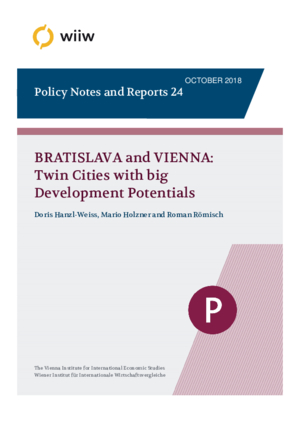BRATISLAVA and VIENNA: Twin Cities with big Development Potentials
Doris Hanzl-Weiss, Mario Holzner and Roman Römisch
wiiw Policy Note/Policy Report No. 24, October 2018
29 pages including 2 Table and 18 Figures
The German version can be found here.
The economies of Vienna and Bratislava have followed quite different development paths over the last decades. While Vienna’s population increased by about 20% within two decades, Bratislava’s population mostly stagnated. However, when measured in GDP per capita at purchasing power parties, average income in Bratislava has surpassed that of Vienna and is now among the top-10 leading regions in Europe. Massive foreign direct investment, particularly in the automotive sector, has created full employment in Bratislava. Nevertheless, Vienna, as one of the world’s most liveable cities, is still attracting more immigration and labour markets are in less favourable conditions. Transport infrastructure between the two close cities has only recently been improving, which has left considerable scope for further reductions in travel time. Regional cooperation is under way and should be reinforced in order to meet the challenges ahead. Mass-emigration of young Slovaks over the last decades will lead to a rapid ageing in Slovakia over the next decades and the working age population is expected to shrink by almost a third by the end of the century, while Austria’s will mostly stagnate. By creating a truly common labour market in the twin-city region, Bratislava could solve the problem of labour shortages and Vienna could solve its youth unemployment problem. Policy recommendations in this respect include inter alia a more substantial improvement of intercity public transport; common educational planning and training programmes; and, commuter allowances during the nominal wage-equalisation-transition. Other major long-run challenges are the ongoing processes of digitalisation and robotisation. Here, policy recommendations include projects of innovation cooperation; coordination of innovation oriented public procurement; and, improvement of transport infrastructure to connect the twin-city region with the rest of the world in order to reap potential future gains from increased economies of scale.
Keywords: Bratislava, Vienna, urban development, regional labour markets, education, R&D, demographic trends, wage differentials, technological change
JEL classification: O18, R23, I23, J11, J31, O33
Countries covered: Austria, Slovakia
Research Areas: Labour, Migration and Income Distribution, International Trade, Competitiveness and FDI
